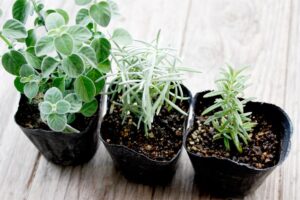
Growing herbs at home is a great hobby that brings delicious food, beautiful greenery, and peace of mind.
Many people use herbs to add flavor to their dishes, but there’s nothing quite like growing your own.
Herb cultivation, which can be started in a limited space such as the kitchen window, balcony, or garden, can be a beginner-friendly introduction to gardening.
In this article, we’ll explain how to get started with the basics of herb cultivation, the tools you’ll need, tips on how to grow them, and the many benefits you can get from growing them.
Take the first step to growing fresh herbs at home and enjoying their aroma and flavor in your cooking and daily life.

目次
- 1 Basics of herb cultivation: Benefits of growing herbs at home
- 2 A step-by-step guide to growing herbs for beginners
- 3 How to find the best place to grow herbs at home
- 4 Common problems and solutions in herb cultivation
- 5 How to use herbs after harvest
- 6 Ideas to further enjoy growing herbs at home
- 7 summary
Basics of herb cultivation: Benefits of growing herbs at home
Starting to grow herbs at home not only provides fresh ingredients for delicious dishes, but also brings beauty and healing to your daily life.
In this section, we explore the basics of growing herbs at home and their wide range of benefits.
The charm of herbs that decorate your kitchen
The best part about growing herbs at home is that you can always use fresh herbs in your cooking.
For cooking enthusiasts, being able to easily harvest a variety of herbs such as basil, parsley, and mint right in the kitchen is a joy.
Herbal greens also bring life and color to your kitchen, making cooking time even more enjoyable.
Comfortable healing that can be obtained from herb cultivation
Cultivating herbs can also lead to mental relaxation and stress reduction.
The scent of herbs is said to have a calming effect, and taking care of them daily can be a pleasant and healing time in itself.
You can also start growing in a small space, so you can enjoy greenery even in your urban apartment.
By starting to grow herbs, you can not only improve the quality of your cooking, but also have a positive impact on your overall life.
The following section provides a step-by-step guide that allows even beginners to easily start growing herbs.
A step-by-step guide to growing herbs for beginners
Herb cultivation is one of the hobbies that even beginners can easily start.
But there are basic steps and tricks you should know before you start.
This guide will walk you step-by-step through the process of growing herbs at home in an easy-to-understand manner, even for beginners.
Let’s take a closer look at the tools you’ll need, how to choose herbs, how to plant them, and how to care for them on a daily basis to ensure you’re on the path to success.
Tools and materials needed for herb cultivation
The tools and materials you need to prepare before you start growing herbs are:
- Planters and pots : The optimal size and depth will vary depending on the type of herb.
- Potting mix : Choose soil with good drainage and aeration for growing herbs.
- Seeds or seedlings : Beginners are advised to start with seedlings, which grow quickly.
- Watering can : Proper water management is important.
- Labels or markers : To record the names of the herbs you planted and the date they were planted.
From how to choose to how to plant: A guide to each type of herb
There are many different types of herbs, each with different growing conditions.
- Basil : Prefers a sunny and well-drained location. Fertilize once a month for good growth.
- Parsley : Can be grown indoors as it grows in partial shade. Keep the soil moist at all times.
- Mint : Hardy and fast growing, it is recommended to grow it in a separate pot from other herbs.
If you follow these steps and advice, even beginners can grow herbs at home.
Through daily care, you will be able to enjoy the growth of herbs and experience the joy of using fresh herbs in cooking.
The next section details how to find the best place to grow herbs.
How to find the best place to grow herbs at home
Successful herb cultivation begins with choosing the right location.
Where you grow herbs in your home depends on the type of herb, available space, and sunlight requirements.
This section provides tips for finding the best place to grow herbs at home.
Sunlight and watering: conditions for herbs to grow
Many herbs prefer full sunlight. Generally, at least 6 hours of direct sunlight per day is recommended.
Windows, balconies, and terraces are ideal for growing herbs because they receive plenty of sunlight.
In addition, it is important to water only when the soil surface is dry, but be careful not to overwater as this can cause root rot.
Indoor or outdoor cultivation: Optimal environment for each herb
Depending on the type of herb, it may be better outdoors than indoors.
For example, rosemary and lavender prefer more sunlight and airflow, so they do best outdoors.
On the other hand, plants such as basil and mint can also be grown indoors.
Choose the optimal cultivation location by considering your home environment and the characteristics of the herb.
It is important to consider these conditions when choosing a place to grow herbs at home.
If you find the right place, herbs will grow healthily and enrich your life.
In the next section, we’ll dig deeper into common herb growing problems and their solutions.
Common problems and solutions in herb cultivation
In the process of growing herbs at home, you may face various challenges.
However, effective solutions exist to these common problems.
This section covers common problems in growing herbs and provides specific advice for overcoming them.
How to deal with overwatering or underwatering
One of the most common problems in herb growing is finding the right watering balance.
Different types of herbs have different water requirements, but the general rule of thumb is to water when the soil is dry.
To prevent overwatering, make sure that excess water drains out of the holes at the bottom of the pot, and wait until the soil surface is dry before watering.
Prevention and countermeasures against pests and diseases
Preventing and dealing with pests and diseases is important to keep herbs healthy. Observe your herbs regularly to check for any abnormalities in the leaves or stems.
If you find any pests, you can treat them with a naturally friendly spray of soapy water.
If you notice any signs of illness, remove the infected area as soon as possible and take appropriate measures.
By taking these measures, you can help your herbs grow healthily and increase your success rate.
In the next section, we’ll dig deeper into how to use herbs after harvest.
How to use herbs after harvest
One of the joys of growing herbs is being able to use their bounty in a variety of ways after harvesting.
In this section, we explore how to make the most of your harvested herbs.
We will introduce a wide range of topics, from dishes using fresh herbs to ways to use them for beauty and health.
Collection of recipes using fresh herbs
Home-grown herbs add depth and flavor to your dishes.
From pesto sauce with basil to roasted chicken with rosemary to fresh salads with mint, there are endless recipes that incorporate herbs.
You can also easily make herbal teas and dressings using herbs to elevate your everyday meals.
Natural beauty and health methods using herbs
Herbs are also useful for beauty and health. For example, lavender has a very relaxing effect, and by using it during bath time, you can heal the fatigue of the day.
Rosemary is also said to promote blood circulation in the scalp and support hair health.
There are also plenty of recipes for beauty waters using herbs that can be easily made at home, and herbal teas that support your health.
The real pleasure of growing herbs lies not only in the process of growing them, but also in the variety of ways they can be used afterwards.
Use the herbs you have harvested to enrich your daily life.
By fully enjoying the scent and efficacy of herbs, you will be able to live a more fulfilling lifestyle.
Ideas to further enjoy growing herbs at home
Growing herbs at home opens the door to many more creative activities, not just cooking, health and beauty.
In this section, we explore unique ideas to extend the fun of growing herbs and add color to your daily life.
Home aroma products made with herbs
Herbal scents not only make your home more comfortable, but also have the effect of promoting relaxation and concentration.
You can make aroma candles, room sprays, and potpourri using herbs you grow at home.
For example, lavender can help improve sleep quality, and peppermint has a refreshing effect, making it a good choice for your workspace.
These DIY aroma products are great for home use or as thoughtful gifts.
Connecting with a community that enjoys herb cultivation as a hobby
Growing herbs provides a great opportunity to connect with people who share your interests.
Share growing tips and new ideas by joining online forums and social media groups.
Joining a local herb growing club or workshop is also an opportunity to expand your knowledge and make friends with similar interests.
By learning together and receiving inspiration from each other, you can experience the joy of herb cultivation even more deeply.
Growing herbs at home has multifaceted value beyond just a hobby.
Let’s further expand the fun of herb cultivation through DIY projects that utilize herbs and interaction with the community.
These ideas will make your time with herbs richer and more meaningful.

summary
Growing herbs at home not only adds fresh flavor to your dishes, but also serves as a source of beauty and healing, adding rich value to your daily life.
Through this article, we have introduced a wide range of topics, including the basics of herb cultivation, various ways to use them after harvesting, and even ideas for deepening herb cultivation as a hobby.
Herb cultivation is one of the hobbies that anyone can start. To get started, all you need is a little space, some basic growing tools, and the seeds of the herb you want to grow.
Watching herbs grow through daily care can be a small pleasure in everyday life, and it can also lead to mental healing.
Dishes using the herbs you harvest will make your meals even richer.
You can also fill your home with natural scents by making DIY beauty and aroma products using herbs.
The knowledge and experience you gain through herb cultivation can be shared online and with your local community, making it even more fun.
Growing herbs at home not only enriches your life, but can also be a step towards a sustainable lifestyle.
Achieve a richer life by incorporating the beauty and scent of herbs into your daily life.




